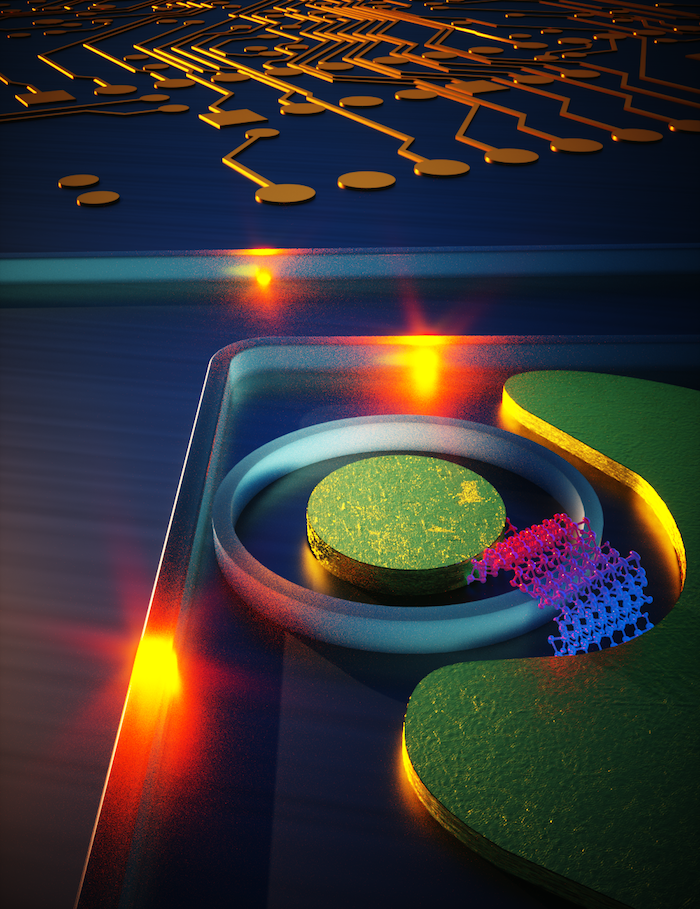Jun 23 2020
A new method has been identified by scientists to engineer optoelectronic devices. This involves extending a two-dimensional (2D) material on top of a silicon photonic platform.
 Artistic representation of a strain-engineered 2D photodetector on silicon photonic circuit. Image Credit: The George Washington University.
Artistic representation of a strain-engineered 2D photodetector on silicon photonic circuit. Image Credit: The George Washington University.
By employing this technique, termed strainoptronics by a research team under the guidance of the George Washington University professor Volker Sorger, the researchers have shown for the first time that a 2D material covered around a nanoscale silicon photonic waveguide makes an innovative photodetector that has the ability to function with high efficiency at the technology-critical wavelength of 1550 nm.
This kind of new photodetection can optimize computer systems and future communications, particularly in evolving fields such as artificial neural networks and machine learning.
The Situation
There has always been an ever-increasing data demand for modern societies, which in turn leads to the need for more efficient conversion of data signals in the optical domain, ranging from electronic devices, such as laptops or smartphones, to fiber-optic internet.
This process of conversion from optical to electrical signals is carried out by a photodetector, which is a crucial building block for optical networks.
In the case of photodetectors, 2D materials possess scientific and technologically applicable properties. Developing a 2D material-based photodetector would allow an enhanced photo-conversion due to their powerful optical absorption, and, therefore, more efficient data transmission and telecommunications can be achieved.
But 2D semiconducting materials such as those from the class of transition metal dichalcogenides, have been incapable of working efficiently at telecommunication wavelengths so far due to their low absorption and wide optical bandgap.
The Solution
Strainoptronics offers a solution to this defect and provides an engineering tool for scientists to alter the 2D materials’ optical and electrical properties, resulting in the development of 2D material-based photodetectors for the first time.
The researchers realized the potential of strainoptronics and expanded an ultrathin layer of molybdenum telluride—a 2D material semiconductor—over a silicon photonic waveguide to develop an innovative photodetector.
The researchers utilized their newly developed strainoptronics “control knob” to modify its physical properties to reduce the electronic bandgap, enabling the device to work at near-infrared wavelengths, specifically at the telecommunication (C-band) related wavelength of about 1550 nm.
One fascinating feature of the discovery was that these semiconductor 2D materials could endure a considerably higher amount of strain compared to bulk materials, for a specific amount of strain.
The team also observed that these novel 2D material-based photodetectors are 1,000 times more sensitive than other photodetectors developed with graphene. Photodetectors that can produce such extreme sensitivity are useful not just for data communication applications but also for medical sensing and perhaps even in quantum information systems.
From the Researchers
We not only found a new way to engineer a photodetector, but also discovered a novel design methodology for optoelectronic devices, which we termed ‘strainoptronics’. These devices bear unique properties for optical data communication and for emerging photonic artificial neural networks used in machine learning and AI.
Volker Sorger, Associate Professor, Electrical and Computer Engineering, The George Washington University
According to Rishi Maiti, postdoctoral fellow in the electrical and computer engineering department at The George Washington University, “Interestingly, unlike bulk materials, two-dimensional materials are particularly promising candidates for strain engineering because they can withstand larger amounts of strain before rupture.”
Maiti continued, “In the near future, we want to apply strain dynamically to many other two-dimensional materials in the hopes of finding endless possibilities to optimize photonic devices.”
This study was financially supported by the Army Research Office (W911NF-16-2-0194) and the Air Force Office of Scientific Research (FA9550-17-1-0377).
Journal Reference
Maiti, R., et al. (2020) Strain-engineered high-responsivity MoTe2 photodetector for silicon photonic integrated circuits. Nature Photonics. doi.org/10.1038/s41566-020-0647-4.